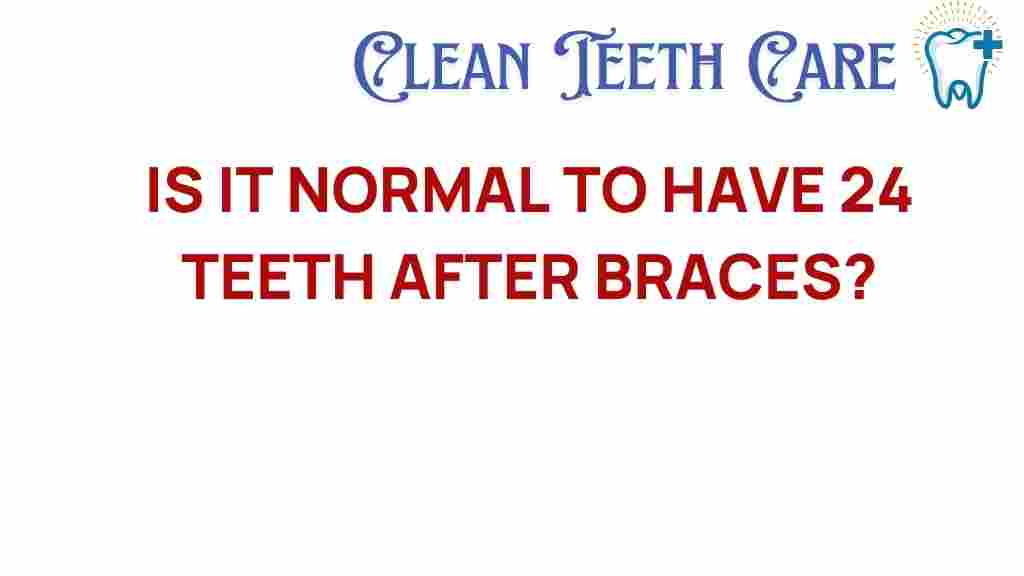The Surprising Truth About Having 24 Teeth After Braces
Many people embark on the journey of orthodontics, dreaming of a perfect smile. One common question that arises during this process is, “Why do I have only 24 teeth after braces?” This article delves into the fascinating world of dental health, tooth development, and the truth behind braces and the number of teeth you might have post-treatment. We will also address some prevalent dental myths, the importance of oral care, and how you can achieve a smile transformation that lasts.
Understanding Teeth Count and Development
Before we discuss braces and their impact on teeth count, it’s essential to understand how many teeth a typical adult should have. Most adults have 32 teeth, including wisdom teeth. However, some individuals may have 28 or even 24 teeth after braces due to various factors:
- Tooth Extraction: During orthodontic treatment, some patients may need teeth extracted to create space for the remaining teeth to align properly.
- Wisdom Teeth Removal: Many people have their wisdom teeth removed, which can reduce their overall teeth count.
- Congenital Conditions: Some individuals naturally have fewer teeth due to genetic factors.
The Role of Braces in Oral Care
Braces are a critical part of orthodontics, designed to straighten teeth and improve overall dental health. Here are some key roles braces play in oral care:
- Alignment: Braces help align teeth properly, which can prevent future dental issues, such as cavities and gum disease.
- Bite Correction: They also correct bite issues, reducing the risk of jaw pain and other complications.
- Aesthetic Improvement: A well-aligned smile boosts confidence and can lead to better overall oral hygiene practices.
Step-by-Step Process of Getting Braces
Understanding the process can help demystify braces and their impact on your teeth count:
- Initial Consultation: Your orthodontist will assess your dental health, discuss your goals, and create a treatment plan.
- X-Rays and Molds: You’ll undergo X-rays and molds to evaluate your teeth and jaw structure.
- Brace Installation: Braces are placed on your teeth, and adjustments will be made throughout your treatment.
- Regular Check-Ups: Routine visits to the orthodontist are essential for monitoring progress and making necessary adjustments.
- Post-Braces Care: Once your braces are removed, you may need to wear a retainer to maintain your new smile.
Post-Braces: What to Expect
After the braces are off, it’s common for patients to feel a mix of excitement and confusion about their new smile. Here’s what to expect:
- Initial Sensitivity: Your teeth may feel sensitive right after the removal of braces.
- Retainer Use: Wearing a retainer is crucial for maintaining teeth position and preventing relapse.
- Changes in Bite: It may take time to adjust to your new bite.
Common Dental Myths
With the numerous myths surrounding braces and dental health, it’s vital to separate fact from fiction. Here are some common dental myths:
- Myth 1: Braces are only for children and teenagers.
Fact: Adults can benefit from braces too! - Myth 2: Having braces means you can’t eat anything.
Fact: While some foods should be avoided, a balanced diet is still possible. - Myth 3: Teeth can’t shift after braces.
Fact: Without proper retainer use, teeth can shift over time.
Oral Care Tips After Braces
Maintaining excellent oral care post-braces is essential for preserving your smile transformation. Here are some tips:
- Brush Regularly: Brush at least twice a day with fluoride toothpaste.
- Floss Daily: Flossing helps remove plaque and food particles between teeth.
- Use Mouthwash: Antimicrobial mouthwash can help reduce plaque build-up.
- Regular Dental Visits: Keep up with regular dental check-ups to monitor your dental health.
Troubleshooting Common Issues
Even after braces, you may experience some issues. Here’s how to troubleshoot them:
- Teeth Sensitivity: Use sensitivity toothpaste and consult your dentist if it persists.
- Retainer Problems: If your retainer feels uncomfortable, consult your orthodontist for adjustments.
- Staining: If your teeth become stained, professional cleaning can help restore their appearance.
Conclusion
Having 24 teeth after braces can be surprising, but understanding the factors that contribute to this number can help alleviate concerns. Braces play a significant role in transforming your smile while promoting better dental health. By maintaining proper oral care and debunking dental myths, you can ensure the longevity of your smile transformation. Remember, your journey to a perfect smile doesn’t end when the braces come off; it requires ongoing care and attention.
If you have more questions about braces, dental health, or orthodontics, don’t hesitate to reach out to your orthodontist or consult reliable resources. For further reading on dental care, check out this comprehensive guide on oral health.
For an in-depth discussion about oral care and braces, visit this informative page that covers various topics surrounding dental health.
This article is in the category Conditions and created by CleanTeethCare Team
